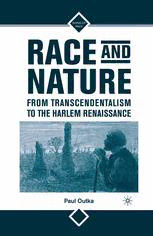
Race and Nature from Transcendentalism to the Harlem Renaissance PDF
Preview Race and Nature from Transcendentalism to the Harlem Renaissance
Race and Nature from Transcendentalism to the Harlem Renaissance SIGNS OF RACE Series Editors: Phillip D. Beidler and Gary Taylor Writing Race across the Atlantic World: Medieval to Modern Edited by Phillip D. Beidler and Gary Taylor (January 2005) Buying Whiteness: Race, Culture, and Identity from Columbus to Hip-Hop By Gary Taylor (January 2005) English and Ethnicity Edited by Janina Brutt-Griffler and Catherine Evans Davies (December 2006) Women & Others: Perspectives on Race, Gender, and Empire Edited by Celia R. Daileader, Rhoda E. Johnson, and Amilcar Shabazz (September 2007) The Funk Era and Beyond: New Perspectives on Black Popular Culture Edited by Tony Bolden (August 2008) Race and Nature from Transcendentalism to the Harlem Renaissance By Paul Outka (August 2008) Race and Nature from Transcendentalism to the Harlem Renaissance Paul Outka RACE AND NATURE FROM TRANSCENDENTALISM TO THE HARLEM RENAISSANCE Copyright © Paul Outka, 2008. Softcover reprint of the hardcover 1st edition 2008 978-0-230-60296-0 All rights reserved. First published in 2008 by PALGRAVE MACMILLAN® in the US—a division of St. Martin’s Press LLC, 175 Fifth Avenue, New York, NY 10010. Where this book is distributed in the UK, Europe and the rest of the world, this is by Palgrave Macmillan, a division of Macmillan Publishers Limited, registered in England, company number 785998, of Houndmills, Basingstoke, Hampshire RG21 6XS. Palgrave Macmillan is the global academic imprint of the above companies and has companies and representatives throughout the world. Palgrave® and Macmillan® are registered trademarks in the United States, the United Kingdom, Europe and other countries. ISBN 978-1-137-28052-7 ISBN 978-0-230-61449-9 (eBook) DOI 10.1007/978-0-230-61449-9 Library of Congress Cataloging-in-Publication Data Outka, Paul. Race and nature from transcendentalism to the Harlem Renaissance / Paul Outka. p. cm.—(Signs of race) 1. Racism—United States—History—19th century. 2. Racism— United States—History—20th century. 3. African Americans— Race identity. 4. Whites—Race identity—United States. 5. Philosophy of nature—United States—History. 6. Wilderness areas—Social aspects—United States—History. 7. Wilderness areas—Political aspects—United States—History. 8. Environmentalism— Social aspects—United States—History. 9. Environmentalism— Political aspects—United States—History. 10. United States—Race relations. I. Title. E185.61.O88 2008 305.800973—dc22 2008000235 A catalogue record of the book is available from the British Library. Design by Newgen Imaging Systems (P) Ltd., Chennai, India. First edition: August 2008 10 9 8 7 6 5 4 3 2 1 Transferred to Digital Printing in 2010. Contents List of Illustrations vii Series Editors’ Preface ix Acknowledgments xi 1 Introduction: The Sublime and the Traumatic 1 2 The Colonial Pastoral, Abolition, and the Transcendentalist Sublime 27 3 “Behold a Man Transformed into a Brute”: Slavery and Antebellum Nature 51 4 Trauma, Postbellum Nostalgia, and the Lost Pastoral 81 5 Trauma and Metamorphosis in Charles Chesnutt’s Conjure Tales 103 6 Strange Fruit 127 7 White Flight 151 8 Migrations 171 Coda: Prospects for an Antiracist Ecological Sublime 201 Notes 205 Works Cited 245 Index 261 Illustrations 1 Expulsion from the Garden of Eden 28 2 The Last Chattel 82 3 What Is It? 128 4 What Is It? or Man Monkey 132 5 What Is It? An Heir to the Throne or the Next Republican Candidate 133 Series Editors’ Preface T he first thing you see when you enter the permanent exhibits at the Birmingham Civil Rights Institute is a pair of drinking fountains. Over one hangs a sign that says “White.” Over the other hangs a sign that says “Colored.” To the extent that every social identity is to some degree local, the meanings of race in Birmingham, Alabama, necessarily differ, in some demographic and historical particulars, from the meanings of race in North Dakota and Northern Ireland, New York and New South Wales, Cape Town, and Calcutta. But the same questions can be asked everywhere in the English-speaking world. How do people signal a racial identity? What does that racial identity signify? This series examines the complex relationships between race, eth- nicity, and culture in the English-speaking world from the early mod- ern period (when the English language first began to move from its home island into the wider world) into the postcolonial present, when English has become the dominant language of an increasingly global- ized culture. English is now the medium of a great variety of litera- tures, spoken and written by many ethnic groups. The racial and ethnic divisions between (and within) such groups are not only reflected in, but also shaped by, the language we share and contest. Indeed, such conflicts in part determine what counts as “literature” or “culture.” Every volume in the series approaches race from a transracial, inter- disciplinary, intercultural perspective. Each volume in the series focuses on one aspect of the cross-cultural performance of race, exploring the ways in which “race” remains stubbornly local, personal, and present. We no longer hang racial signs over drinking fountains. But the fact that the signs of race have become less obvious does not mean that they have disappeared, or that we can or do ignore them. It is the purpose of this series to make us more conscious, and more critical, readers of the signs that have separated, and still separate, one group of human beings from another.
